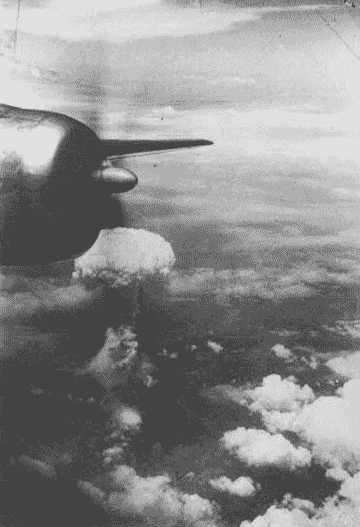AUGUST 6, 2010
Hiroshima

August 6, 1945: an American B-29 bomber named Enola Gay dropped the "Little Boy" atomic bomb on Hiroshima, Japan. Its blast was the equivalent of 13 kilotons of TNT.
Despite the 100,000+ deaths, mostly civilians, I can't totally reject the argument that by unleashing this horrible new weapon many more deaths were avoided. An invasion of Japan was already planned for October.
It's also hard to say that nuclear bombs were worse than the earlier fire-bombing of Japanese cities. In Tokyo alone approximately 100,000 died in the huge firestorm. The war was growing increasingly brutal on a huge scale.
Still, that this much destruction could be created by a single bomb from a single plane meant that the world had become a terribly more dangerous place.
We've lived with that reality ever since.
Nightmare
The looming danger of nuclear war haunted my dreams throughout my college years in Dayton, near the huge Wright Patterson Air Force base. There was no question that if war with Russia broke out (funny how the Cold War seems a quaint memory) Wright-Pat would be a top-level target. No doubt lots of ICBMs were aimed a few miles from my dorm room.
With this underlying tension one night's event created an indelible memory. I was laying in my bed taking my usual after-supper nap. Around 8 pm I heard a big B-52 bomber taking off, flying low overhead. Then another. And another, for ten minutes or more. Where were all these bombers going? Was this it? Had The War started?
I figured there was a good chance my life would end in about twenty minutes, the time we were told would elapse between the detection of a Russian missile launch and detonation. At the same time I clung to an obvious ray of hope: since Wright-Pat was surely an immediate target, if nothing happened in twenty minutes I was home free.
It was a very long twenty minutes.
What could happen
To see what a nuclear explosion would do to your city, type your address into Eric Meyer's HYDESim website. The Explosive Yield for the Hiroshima bomb was about 15 KT (1 KT = 1000 tons of TNT), but you should set the number to 100-500, the yield of warheads in current Trident missiles.
Seeing the concentric circles of destruction spreading from your own neighborhood is a chilling reminder of what still could happen.
And give at least a passing thought to all those Japanese to whom it already did happen.
Top |
|
![]()
